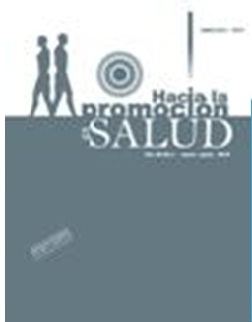Authors
Abstract
Objective: Contribute to the discussion on risks and risk behaviors of a group of working children and teenagers in order to unveil their realities and experiences, new meanings and feelings that will strengthen their ability to care for themselves. Methodology: A qualitative research that illustrates the need to address from a comprehensively look and critical thinking, the conceptions of quality of life and risk behaviors of children and young workers. Results: Risky behavior is not only an exclusive condition of children and young workers, but it is related to their contexts and social stories. Their families have weak symbolic devices to support and provide security, affection and guidance to their children, resulting in a lack of care, which leads them to create other frames of reference and risk behaviors, such as drug use or activities that result in violent situations, theft and damage to private property. Some of them also construct meanings and significance from their daily lives and relationships with adults at home, school, work, which involve their own recognition or subjectivity in terms of self-care practices related to protection from sexual abuse, guard against peer pressure regarding drug use, and protecting younger children from consumption. However, self-care does not eliminate surrounding risk factors (violence, occupational hazards) or consequences that are primarily dependent on social and economic conditions that generate said factors. Conclusions: It is necessary to accommodate working children in institutional settings and respond to their demands, social and cultural rights, and overcome the stigma and blame mechanisms for working or being consumers of psychoactive substances. The need to strengthen the political and social capital of families and working children is observed, in order to enable them to take an active role regarding the defense and guarantee of their rights.
References
Beck U. La sociedad del riesgo. Hacia una nueva modernidad. Barcelona: Paidós; 1998.
Sandoval CA. Investigación cualitativa. Módulo 4. Programa de Especialización en teoría, métodos y técnicas de investigación social. Santafé de Bogotá: ICFES Corcas; 1997.
Galindo LJ. Técnicas de investigación en sociedad, cultura y comunicación. México: Addison Wesley Longman; 1998.
Szekely M. Retos para conceptualizar la medición de la calidad de vida. [Diapositiva]. Washington: Banco Interamericano de Desarrollo BID; 2006. 50 diapositivas.
Alvarado S, et al. Procesos de Construcción Teórica, Métodos y Técnicas en la Investigación en Ciencias Sociales. 2 ed. Manizales: CINDE; 1992. Módulo 1 y 2.
Aristóteles. Ética a Nicómaco. México: Espasa Calpe; 1946.
Veenhoven R. Calidad de vida y felicidad: no es exactamente lo mismo. Publicado en italiano en: G. De Girolamo y col. (eds) Qualita’ della vita e felicita. Centro Scientifico Editore, 2001 [citado 5 julio de 2009] Torino, Italia. Traducido al español por Catalina Aguiló, segunda corrección por Vanessa González Aerero. Disponible en: www.fun_humanismo-ciencia.es/felicidad
Sen A. Desarrollo y libertad. Barcelona: Planeta; 2000.
Arriagada J, Benítez O, Castro MR, Cuty Da Silva JA, Garrido M, Maciel G, et al. Guía para la implementación de un Sistema de Inspección y Monitoreo del Trabajo Infantil en los países del MERCOSUR y Chile. Lima, OIT/ Programa IPEC Sudamérica; 2003. (Serie: Documentos de Trabajo, 169).
Tenti F. En García ML. Trabajo infantil y experiencia escolar [en línea]. Buenos Aires: IIPE UNESCO; 2006 [acceso 13 de septiembre de 2009]. Disponible en: http://www.pronino.com.ar/pdfs/actividades2006_trabajoinfantil_libro.pdf
Forselledo A. Uso Indebido de Drogas, Derechos del Niño y Políticas Públicas para la Prevención. Montevideo: Instituto Interamericano del Niño; 2002.
Casas F. Bienestar social. Una introducción psicosociológica. Barcelona: PPU; 1996.
Schalock R, Verdugo MA. Calidad de Vida. Manual para profesionales de educación, salud y servicios sociales. Madrid: Alianza Editorial; 2003.
Nussbaum M, Sen A. La calidad de vida. México: Fondo de Cultura Económica; 1996.
Tonón G. La propuesta teórica de la calidad de vida. Hologramática [en línea]; 2007 [acceso 15 de agosto de 2009]; (7):15-21. Disponible en: http://www.cienciared.com.ar/ra/doc.php?n=693
Sen A. ¿Cuál es el camino del desarrollo? En: Revista Comercio Exterior 1985; 35(10):939-949.
Maluf N. Acerca del enfoque de riesgos. Investigación sobre niños, niñas y adolescentes en situación de riesgo. Quito: FLACSO-MBS. Banco Interamericano de Desarrollo; 2002.
Donoso C. Charles Taylor: una crítica comunitaria al liberalismo político. Polis Revista On-Line. Universidad Bolivariana 2000;6(2).
Cerbino M, Cevallos F. Imágenes e imagineros de la conflictividad juvenil y de las organizaciones pandilleras. Investigación sobre niños, niñas y adolescentes en situación de riesgo. Quito: FLACSOMBS-BID; 2002.
Galende B, Picco E. Trabajo infantil su impacto en la constitución subjetiva. Kairos Revista de Temas Sociales 2001;(8).


 PDF (Español)
PDF (Español)
 FLIP
FLIP






















